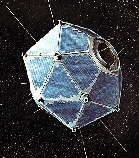The Vela-5B Satellite Vela-5B was part of a series of US Vela satellites.The program was run jointly by the Advanced Research Projects of the U.S. Department of Defense and the U.S. Atomic Energy Commission, managed by the U.S. Air Force. They were not intended primarily for astronomical studies but did provide much useful celestial data. The Vela-5A and 5B satellites were launched in 1969 and Vela-6A and 6B in 1970 and they operated in spinning mode. Each operated for about a year except Vela-5B which provided data until mid 1979. Mission Characteristics
Page authors: Lorella Angelini Jesse Allen HEASARC Home | Observatories | Archive | Calibration | Software | Tools | Students/Teachers/Public Last modified: Thursday, 24-Sep-2020 21:32:09 EDT |

